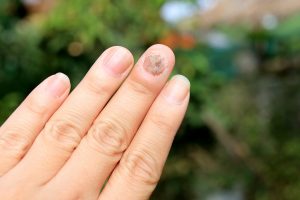Nail Fungus
It’s easy to get a fungal nail infection. If you have a fungal infection on your foot, the fungus can spread to one or more of your nails. This is quite common.
You can also catch a fungal nail infection in a warm, moist place like a pool deck or locker room. If someone else has a fungal infection and walked barefoot there, all you have to do is walk barefoot in the same area.

Having wet nails for a long time can also lead to nail fungus. Some people develop it when they wear the sam
e pair of sweaty shoes or boots every day. Fingernails that are wet for hours at a time due to a job or hobby are also susceptible.
What you see on infected nails will vary with the type of fungus causing the infection.
Most people see some nail discoloration. The nail may have a white spot. Some nails turn yellow, brown, or green. As the infection worsens, infected nails can thicken, lift up from the finger or toe, or crumble. Some nails become thinner.
Treatment is important. It can prevent the infection from causing more damage to your nails.
If you have diabetes or a weakened immune system, treatment is especially important. After getting a fungal nail infection, people who have diabetes have an increased risk of developing sores that do not heal. Sores that do not heal can lead to a serious health problem. It’s important to see a dermatologist (or other doctor) at the first sign of a nail problem. A dermatologist can tell you whether you have a nail infection or something else.
Early diagnosis and treatment are recommended for everyone who has nail fungus. Caught early and treated, a fungal nail infection is likely to clear and you’ll regrow a healthy nail.
Treatment can also prevent the fungus from spreading to other parts of your body and to other people.
You cannot get rid of a nail infection by covering it with nail polish or artificial nails
Fungal infections are contagious, so you can get another one. Taking the following precautions can reduce your risk.
12 WAYS TO PREVENT ANOTHER NAIL INFECTION
1. Wear flip flops or shower sandals when walking in warm, moist areas like gyms, locker rooms, spas, public showers, and pools. This can prevent you from catching nail fungus and athlete’s foot.
2. If you just finished treating nail fungus, throw away shoes, boots, skates, and other footwear that you wore before you started treatment. Fungus can live in footwear, giving you another infection.
If your footwear is expensive or new, you can disinfect them using an ultraviolet (UV) shoe sanitizer or ozone cabinet. You can buy these online.
Keep flip flops near the pool. That way, you can slip into them when you get out of the water.
3. Put on a clean pair of socks every day and whenever your socks get sweaty. This helps prevent fungi from growing. Wearing moisture-wicking socks can also reduce the need to change your socks.
4. Wear shoes that:
- Fit well (not tight)
- Are made of leather, canvas, or mesh
- Keep your feet dry and prevent overheating
This helps prevent fungi from growing in your shoes.
1. Alternate shoes. Fungi thrive in moist places like damp shoes. You can reduce this growth by giving shoes 24 hours to dry out before wearing them again.
2. Sprinkle antifungal powder in your shoes. These products cannot treat a fungal nail infection, but they can help prevent fungus from growing in your shoes.
3. Keep your nails short. When trimming your toenails, you want to cut them straight across and keep your toenails shorter than the end of your toes. Fingernails should also be kept short. This helps prevent fungi and other germs from getting under your nails.
4. Sanitize your nail clipper before using it. To sanitize your nail clipper, wash it with soap and water and then wipe it with rubbing alcohol.
If you go to a salon for nail care, ask how often they disinfect nail clippers, emery boards, and other equipment. They should sanitize these after every client. If not, the equipment can spread a fungal infection from one client to another.
5. Never share nail clippers, shoes, skates, towels, and other personal items. You can easily pick up a fungal infection by sharing a personal item. People also get athlete’s foot and ringworm (a fungal infection on the skin) by sharing personal items.
6. Keep your feet clean and dry. Carefully wash your feet with soap and water every day, taking care to wash between your toes. Dry your feet well after washing them.
You also want to avoid having damp or sweaty feet for too long. A damp, warm area provides the perfect area for fungi to thrive.
7. Moisturize dry skin. Fungi can get in through small cracks in your skin. To ease dry skin, moisturize within 5 minutes of bathing and after washing your hands.
8. If you get athlete’s foot, treat it right away. Fungi also cause athlete’s foot. This fungal infection can spread to your nails.
To rid the infection, Bella Aesthetica MedSpa uses lasers and light treatments to clear nail fungus.

